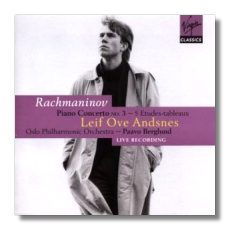
The Internet's Premier Classical Music Source
Related Links
- Rachmaninoff Reviews
- Latest Reviews
- More Reviews
-
By Composer
-
Collections
DVD & Blu-ray
Books
Concert Reviews
Articles/Interviews
Software
Audio
Search Amazon
Recommended Links
Site News
 CD Review
CD Review
Sergei Rachmaninoff

Piano Concerto #3
- Concerto for Piano & Orchestra #3 in D minor, Op. 30
- Études-tableaux: Op. 33 #1, 2, 3 & 6
- Étude-tableaux: Op. 36 #6
Leif Ove Andsnes, piano
Oslo Philharmonic Orchestra/Paavo Berglund
Virgin Classics CDC5451732 DDD 57:35
Reissued on EMI 62837
Amazon
- UK
- Germany
- Canada
- France
- Japan
With the death of Shura Cherkassky last December, perhaps there really are no more "last Romantics." If that's the case, then let's have some new ones. Leif Ove Andsnes's pianism is not from the same school as Cherkassky's or Horowitz's, but that's no reason for despair. Perhaps we should start to think of him (and Kissin, and Hough, and so on) as the "first New-Romantics." As one direction ends, another begins. We're going to be hearing a lot from Leif Ove Andsnes in the next century, and perhaps he'll be called "the last Romantic" around the year 2056.
Rachmaninoff's Second Piano Concerto has the good tunes, but the Third Concerto, with its many blatant opportunities for virtuosic display, is the one that can transform a mild-mannered audience into a screaming rabble. (This is true even when the performance is not very good, technically-speaking – hear Horowitz's last recording of the work.) Although he comes close, Andsnes doesn't quite start a riot on this live recording. Still, this is a very exciting and impressive performance, and the audience's enthusiastic response is well-deserved. Andsnes's playing is distinguished by its articulation, even at the highest speeds. Even live (granted that this recording is a composite of several performances, both with and without an audience present), very few passages are smeared, although the climax at 8:37 in the first movement is somewhat garbled. His legato playing sings, and his tone is very clear. Compared to the many pianists who have made notable recordings of this concerto, Andsnes takes a lighter approach, even in the original (and heavy) version of the first movement cadenza. This tends to make his Rachmaninoff sound less Russian and more like Grieg, which is a refreshing change. On the down side, the orchestra tends to overpower him, and, on this recording at least, the piano is missing the tonal richness in the lower registers that a Horowitz could summon at the drop of a wrist. Overall, though, this is a stunning performance – certainly one of the best from the digital era. The five Études-tableaux are even more recommendable. The first of the five (in A Minor, Op. 39, #6) is played as a live encore, and is introduced by young Andsnes himself. (It's amazing how one can identify a Scandinavian just by the lilting way in which he says "Rachmaninoff: Étude-tableau.") As with the concerto, these five solo pieces are played with incredible dexterity and clarity, but with not so incredible warmth. Truth to tell, I think that the pianist is a little let down by either his piano or his engineers, because I haven't noticed this problem on his earlier recordings.
Through not fault of his own, Andsnes hasn't impressed American audiences the way that Kissin has – yet. With the release of this recording, now is a good time to start.
Copyright © 1996, Raymond Tuttle


















